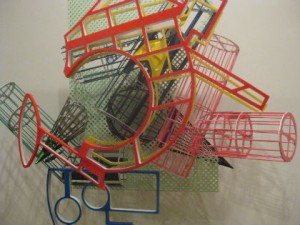If you perchance see a hammer and sickle in this abstract Frank Stella sculpture, don’t bother paging doctor Rorschach. It is impossible not to see.
Certainly, the rest of the dynamic caged forms here recall early Soviet art. If nothing else, they resemble parts of Vladimir Tatlin’s famous tower.
But they are also post industrial. The piece was an early example of computer aided design. The communist tools of industry and agriculture are coming apart.
One reason for this drift, may in this case be the booming economy of the 1980s. Mint gauze and other candy colours recall the postmodern look of the decade in which this work was begun.
But La Penna di hu is not completely virtual. The nude pink cylinder protuding on the right appears to offer this explosive work a physical, manual way in.
Hardly visible in this picture, a small unpainted cogwheel is attached to a threaded rod. It is as if you could reach in and tighten up the whole contraption.
This suggests engineering rather than sculpture, recalling the technical stages in which the work was developed at Tyler Graphics Laboratory in New York.
And all in all, this bright and poppy machine-like piece is one for inspection rather than for passive enjoyment. If you want a closer look you can even get behind it.
But you might never get your head around the way it channels, funnels, layers and breaks up space. There’s no telling what would happen if that cog was twisted.
It might reunite the hammer and sickle. Or more likely, it would lead to new forms, and new icons. Perhaps whole new ideologies.
The current show at Haunch of Venison, Burlington Gardens, (running until November 19) devotes a room to variations of this piece. See gallery website for more details
By luck, a scale model of Vladmir Tatlin’s Monument to the Third International is currently under construction in the courtyard ot the Royal Academy just around the corner.
There are at least two decent artist interviews online, but they appear to contradict each other. The Telegraph met competitive Frank Stella. Whereas The Believer met a Stella who said that it’s not about winning.
By the way, does anyone know where the name of this series, La penna di hu, comes from?

